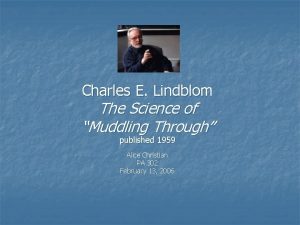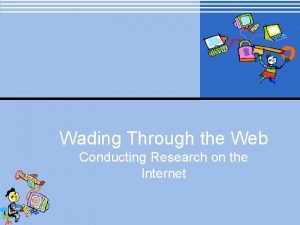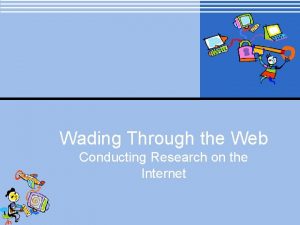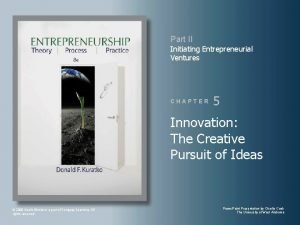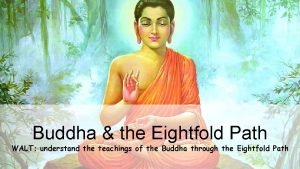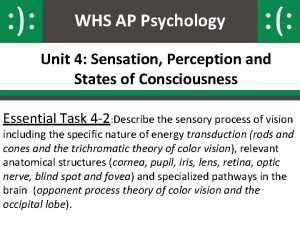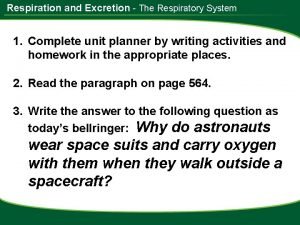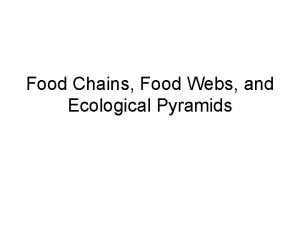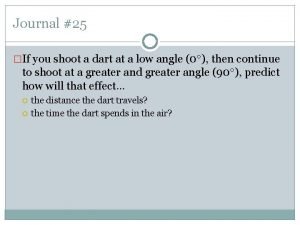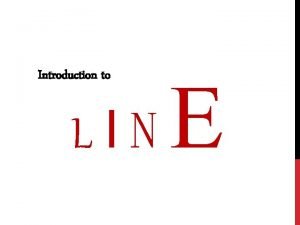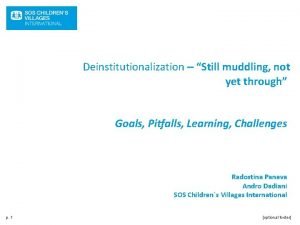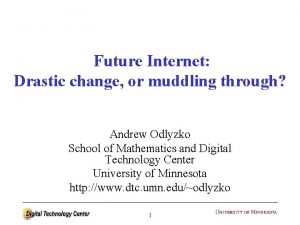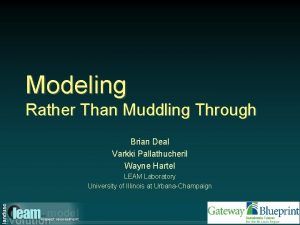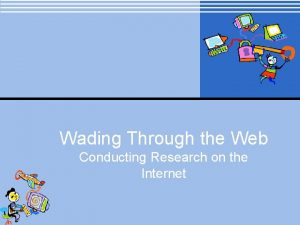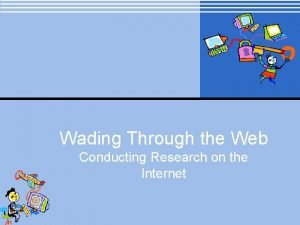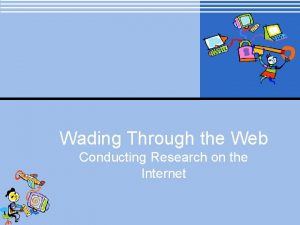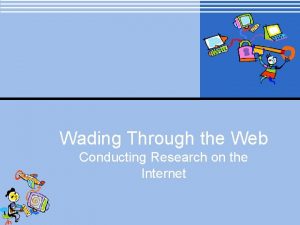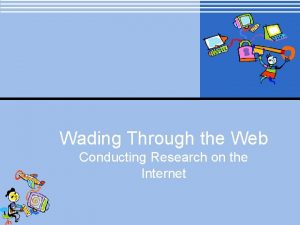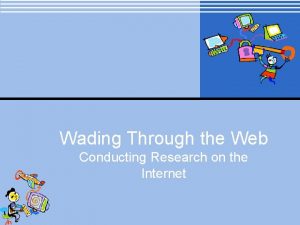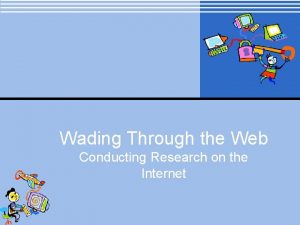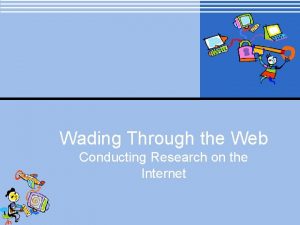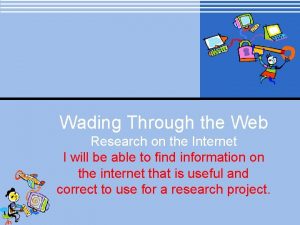Muddling Down a Middle Path Wading through the












































- Slides: 44

Muddling Down a Middle Path: Wading through the Messiness of Life by Bob Daniel, Ph. D. Tidewater Psychotherapy Services

When you come to a crossroads, where you must choose one path or another, how do you choose? A. I follow the herd – all those lemmings can’t be wrong. B. I go along with what my partner wants – you know, “happy wife, happy life. ” C. I’m an “off-road” kind of guy – I blaze my own trail. D. I make the most logical, sensible choice. E. As I have done before, in similar situations – I guess I’m just a creature of habit. F. I trust my gut – whatever feels right. G. I pass – I like to keep my options open. H. I flip a coin – whatever comes up was meant to be.

For every problem, there is a simple solution: • A. If you just apply logic to it. • B. But you have to put up with the idiots who are too blind to see it. • C. Both A and B. • D. Except when it is a matter of conflicting underlying values or a paradox, and then you're on your own. • E. Other: _______________

Intuition and Logic: Subjective and Objective Perspectives on “Reality” Subjective • Full, immediate sensory experience – “mindfulness” • Uses imagery & immediate sensory experience • Synthetic – finding similarities, as with metaphors • Systems approach, with an interactive model of change • Holistic – looking at the “big picture” • Experience things as they are Objective • Reflective awareness – stepping back to get perspective • Verbal processing, dealing in concepts, abstractions • Analytic – breaking things down into discrete elements • Linear, cause and effect reasoning • Reductionistic – focus on the “active ingredients” • Goal-oriented, problem-focus

Limitations of Each Approach When Used to the Exclusion of the Other Subjectivity – The Romantic • Lacks practical orientation for getting things done • Difficulty verbalizing the reasoning for one’s choices • Subject to distortion – seeing the world as we want it to be, rather than as it is Objectivity – The Pragmatist • Lacks the richness of immediate sensory experience • Often negative and judgmental (when in response to frustration and problems) • May miss the “unintended consequences, ” unanticipated by a cause-and-effect mindset • Values and goals not included

The Realist vs. the Romantic • This is a common pattern in relationships. • What started out as complementing one another often ends up polarizing the partners, with each adopting a more extreme position to counterbalance the excesses of the other. • The Realist often claims the higher ground by equating the objective perspective with reality “out there” rather than recognizing it as one of various legitimate viewpoints. • This often regresses into a Perfectionist vs. Passiveaggressive Vicious Cycle Pattern.

Integration of the Subjective and the Objective to Achieve a Healthy Perspective on Self • The subjective state of grandiosity is oblivious to one’s flaws and limitations, and takes offense at anyone who might point them out. • Objective self-consciousness, on the other hand, typically focuses on these shortcomings in a rather critical, self-disparaging manner. • An integration of the two perspectives can establish a healthy regard for oneself in spite of one’s flaws and quirks, and compassion because of them. • This involves intrinsic self-worth, not just the conditional self-esteem based our achievements.

Integration of the Subjective and the Objective to Achieve a Healthy Perspective on Others • The subjective state of idealization is illusory, involving perceiving others as we want them to be, not as they really are (e. g. , The Wizard of Oz – “Pay no attention to the little man behind the curtain” –referring to our preference for having experts whom we can trust to lead our way). • The objective appraisal of others tends to be rather critical and judgmental, particularly when they disappoint us, often leading to an unrealistic devaluation of them. • An integration of the two perspectives can establish a genuine positive regard and compassion for them based on a realistic perception of them, warts and all.

Logic: Its Benefits and Its Limitations • Logic applied to our data bank of knowledge and experience can guide us down more effective and efficient paths to our goals, but it won’t tell us much about which goals to pursue. • When logic is the primary basis for making one’s choices, the basic values that determine one’s goal or destination are often assumed, rather than explicitly stated. • Assumed goals are usually consistent with the conventional values of one’s culture, which often go unquestioned. • A logic-based approach is often dismissive of values conflicting with its own assumed underlying values. • When the particular values and goals are called into question, or are in conflict with one another, then rationality is of limited help.

A SOMEWHAT EXAGGERATED DRAMATIZATION OF AN EXTREME LOGICAL PERSPECTIVE ON VALUES AND FEELINGS

EXAMPLES OF PERSONAL VALUES Achievement Loyalty Individuality Consistency Security Affection Sensory Pleasure Purpose in Life Spirituality Freedom Flexibility Spontaneity Security Openness Belonging Adventure Privacy Beauty Order Self-actualization Excitement

When Values Are In Conflict • Not only do these values conflict with one another from time to time, but certain pairs of values are in basic opposition to one another: more of one means less of the other. • We can speak of these as paradoxes, as we have no logical solution that allows us to have both fully at the same time. • Humor draws much of its energy from exposing this internal contradiction and our unsuccessful attempts to overcome these limitations.

PARADOX

PARADOX

PARADOX

What do we mean by Paradox? • An internal contradiction in a statement or a phenomenon that defies a logical or rational explanation for resolving the apparent contradiction. • By this definition, logic or rationality will not solve this puzzle. • Paradoxes are not necessarily problems that need to be solved. They do not necessarily interfere with our living a satisfying, meaningful life, even if they do point to some inherent limitations. • Some paradoxes, though, present inherent contradictions in the human condition that have a direct impact on daily life.

EXAMPLES OF PARADOXICAL DUALITIES OF DAILY LIFE • ORDER/STRUCTURE VS. SPONTANEITY/FREEDOM • BELONGING/CONFORMITY VS. INDIVIDUALITY/ALIENATION • SECURITY/STAGNATION VS. EXCITEMENT/DANGER • BEING/LIVING IN THE PRESENT VS. BECOMING/BUILDING A FUTURE • BEING FOR SELF (SELFISH) VS. BEING FOR OTHERS (SELFLESS) • USING OTHERS VS. RELATING TO OTHERS

SOME PRACTICAL EXAMPLES OF PARADOXICAL DUALITIES IN EVERYDAY LIFE BEING BECOMING SPEND TODAY FOR A VACATION SAVE IN A RETIREMENT FUND FREEDOM ORDER GO DAY BY DAY ON A VACATION, STAYING OPEN TO POSSIBILITIES INDIVIDUALITY EACH PARTNER PURSUING OWN INDIVIDUAL INTERESTS, HAVING PLENTY TO TALK ABOUT, BUT WITH ONLY LIMITED COMMON ACTIVITIES PLAN OUT VACATION, MAKE RESERVATIONS WELL IN ADVANCE TOGETHERNESS PARTNERS “JOINED AT THE HIP, ” USUALLY PURSUING COMMON ACTIVITIES, WITH EACH SELDOM VENTURING OUT ON ONE’S OWN

THE PARADOXICAL NATURE OF CONFLICT Many conflicts reflect the inherent paradoxical nature of human experience, and perhaps of reality itself. And because of their paradoxical nature, these conflicts defy simple, logical solutions. “A paradox is involved which needs to be accepted, tolerated, and not resolved. ” D. W. Winnicott, Playing and Reality, p. 53 “Despite (and perhaps because of) our scientific inventions and discoveries, humans confront paradoxes without adaptive solutions. We are capable of projecting ourselves into the past or future, yet remain tethered to the present. We contemplate the infinite, yet cannot escape our own mortality. We are determined by our histories, yet choose our future. We are our bodies, yet we have bodies. These are all features of the human condition for which science provides no solutions. . It is here, where science falls short, that art speaks and perhaps comforts. ” Robert Daniel, 1986 Just as science has its limitations in dealing with the paradoxes of life, so too does rational, logical problem solving when it comes to dealing with the paradox-based conflicts of daily living. And just as art offers some understanding and comfort on a cultural level, so too does empathy on the personal level of daily living.

The Arts as a Vehicle for Coming to Terms with the Paradoxes of Life • Science and logic are helpful for solving problems of life, whereas the Arts help us accept the limitations posed by life’s paradoxes (“Comic discovery is paradox stated – scientific discovery is paradox resolved. ” Arthur Koestler, The Act of Creation) • The tragic and the comedic represent the two basic artistic approaches to life’s paradoxes • Humor is largely based on the juxtaposition of mutually incompatible perspectives, and thus serves as a viable medium for exposing the paradoxical nature of the human condition. (Note earlier examples. )

Internal Conflict: An Inherent Aspect of the Paradoxical Nature of the Human Condition • Our choices involve trade-offs between conflicting values (e. g. , order vs. freedom, belonging vs. individuality, security vs. excitement) • By definition, there are no either–or, or right-or-wrong answers to paradox-based conflicts. • Without authoritative, clear-cut external answers to life’s paradoxes, we have greater freedom and responsibility to find the answers that work best in our own lives, rather than relying on the experts. (“Pay no attention to the little man behind the curtain. ” from The Wizard of Oz) • The Middle Path. One general rule of thumb: answers toward the middle of the continuum are usually more adaptive than those at the extremes. • With the middle ground covering a broad range of territory, that still leaves considerable latitude regarding finding one’s preferred position.

Barry Goldwater: An Alternate Perspective to the Middle Path Principle • “Extremism in the defense of liberty is no vice. And moderation in the pursuit of justice is no virtue. ” • Ultimate liberty means having no limits or restraints, and thus no rules or order. This allows those with the most power to get their way, which is not just. • This perspective overlooks the inherent paradoxical relationship between freedom and the order that is necessary to insure fairness.

Let Our Feelings Be Our Guide • When our values are in conflict, as with facing a paradoxical quandary, we have no external authority to provide a logical, definitive answer (though many no doubt would offer their services). • While this offers freedom, it also poses uncertainty. • Our values and principles provide us with a compass to guide us when confronted with paradoxical situations. • Our feelings tap into our values on a gut level, and they can steer us in a direction that is right for us.

Examples of How Feelings Direct Us • Anger encourages us to confront situations that are unfavorable for us or to the people we care about. • Love encourages us to approach others we are attracted to. • Anxiety encourages us to proceed with caution, to have a plan before jumping in. • Disgust impels us to avoid noxious situations. • Sadness stops us in our tracks so we can grieve.

Use Judgment: Feelings Can Also Steer Us Off Course • We can feel sorry for ourselves when we need to grieve. • We can surrender through avoidance, rather than just taking a strategic retreat to gain perspective and develop a plan. • We can strike out aggressively, rather than simply asserting our rights. • We can lose ourselves in another, rather than expressing mature love.

Interpersonal Conflict • Our own preferred position on a paradoxical continuum is likely to contrast at least to some degree with the preferred positions of others, leading to some degree of interpersonal conflict. • Since paradoxes are conflicts without objective, logical solutions, we lack external frames of reference to determine the correct approach in our attempts to resolve our differences. • Healthy resolutions usually strike a balance – yet there is a wide range of middle ground in between, presenting plenty of opportunity for legitimate disagreement. • Thus, coordination our own preferred positions with those of others in our lives requires negotiation.

Degree of Involvement in a Relationship The Extremes: Usually Maladaptive The Middle Ground: Typically Healthier Detached Independent Enmeshed Engaged

A Healthy Balance of Yours, Mine and Ours Ideally, the “Ours” overlap is split into thirds: the middle onethird for activities both partners enjoy about equally, and the outer two one-thirds for activities favored more by one or the other. Yours Ours Mine

Continuum of Degree of Structure With the Extremes Usually Dysfunctional, And With the Middle Generally Adaptive Rigid Orderly Flexible Chaotic

INTERPERSONAL CONFLICT: NOT ONLY NORMAL, BUT HEALTHY AND NECESSARY • CONFLICT RESOLUTION IS THE MEANS BY WHICH WE STRIKE A BALANCE BETWEEN BELONGING AND INDIVIDUALITY, TWO ESSENTIAL ASPECTS OF OUR IDENTITY. • CONFLICT RESOLUTIONS ALLOWS US TO STRIKE A BALANCE BETWEEN BEING FOR OTHERS (i. e. , SELFLESSNESS) AND BEING FOR OURSELVES (i. e. , SELFISHNESS). • EACH CONFLICT IS AN OPPORTUNITY TO ADJUST THESE BALANCES. • WITHOUT CONFLICT IN A RELATIONSHIP, WE WOULD HAVE NO WAY OF GAUGING OUR SENSE OF SELF-WORTH AND OUR COMMITMENT TO OUR PARTNER. • WITHOUT CONFLICT, WE WOULD NEVER HAVE TO TAKE A STAND FOR OURSELVES IN THE RELATIONSHIP, THEREBY AFFIRMING OUR SENSE OF SELFWORTH. • WITHOUT CONFLICT, WE WOULD NEVER HAVE TO MAKE A SACRIFICE OUT OF CONSIDERATION OF OUR PARTNER’S NEEDS, SINCE THEIR NEEDS ARE COMPLETELY COMPATIBLE WITH OUR OWN WHEN THERE IS NO CONFLICT.

CONFLICT RESOLUTION TYPICALLY INVOLVES 3 COMPONENTS: • Self-expression – presenting our point-of-view, including our needs, feelings, wants, and desires • Active listening – hearing the other’s perspective and indicating that we hear and understand it through feedback (e. G. , Nodding, paraphrasing, validating, even “reading between the lines. ”) • Bargaining/negotiation – coming to an agreed-upon solution • through compromise (e. g. , 50 – 50, or even 60 – 40 or 70 – 30 solutions) • through collaboration, with brainstorming to come up with “win—win” solutions (e. G. , With 70 – 70, 60 – 80, 90 – 60, or sometimes even 100 – 100 solutions as possible solutions)

Two Components of the Negotiation Process: The Transactional and the Relational • The Transactional Component: Achieving a resolution to an issue that both parties agree to. This is the practical focus of the discussion. • The Relational Component: Developing a deeper relationship through getting to know one another better through the communication process. • Without the latter, the process would be simply a business transaction.

By-products of Conflict Resolution • The relational “by-products” of this process are potentially more valuable than the actual resolution itself. • Vulnerability in expressing one’s feelings, wants and needs, responsiveness to the feelings of others, and willingness to sacrifice can lead to greater humility, compassion, gratitude, and emotional intimacy – all important qualities for self and relationship.

Humility • Humility involves recognizing that you don’t have a monopoly on the truth and that you have your own shortcomings and limitations. • Without humility, you are more prone to humiliation , which often occurs when others discover your flaws before you do, or at least before you acknowledge them. • Humility tends to encourage compassion and support from others.

Compassion • Compassion involves responsiveness to the feelings, wants, and needs of others. • For one to receive compassion, one must exercise vulnerability in expressing one’s feeling, wants, needs, doubts, etc. • Exercising genuine compassion requires the willingness and ability to suspend one’s preconceptions in order to understand the other’s experience on their own terms.

Gratitude • Gratitude is a natural response to another’s expression of compassion and/or readiness to make a sacrifice, but this response is not guaranteed. • One must be humble enough to accept support. • Being staunchly independent deprives others of the opportunity to feel good about extending themselves in support of you.

Emotional Intimacy • When both partners practice humility and vulnerability in showing their feelings, wants, and needs, compassion for one another and gratitude in return, it opens the doors for emotional intimacy. • This process requires trust – both in one’s partner and in oneself. • We develop trust that our partner will not intentionally hurt us, and we develop trust in our own ability to deal with disappointments when they occur.

Sacrifice • If the partners are unwilling to make sacrifices for one another, then it is likely a relationship of convenience, rather than a true emotional bond. • Action speaks louder than words – sacrifice demonstrates a commitment to the partner. • Sacrifice is best done out of love and caring. • When done out of duty and obligation, sacrifice often leaves a bitter aftertaste of resentment in the giver. • When sacrifice involves doing for others what they can or should do for themselves, it undercuts their personal responsibility. This is called enabling. In such cases, saying “no” can be the most loving act.

Letdowns and Disappointments • Disappointments are a natural part of life. • We cannot reasonably expect our partners to be there for us whenever we want – they have lives, too. • Sometimes they will need to say “no” to us in order to say “yes” to themselves – thus affirming their self-worth. • And yes, sometimes they mess up – after all, they are only human, as are we. • Each of these instances provides an opportunity for us to clear away our illusions about them and to see them as they really are, with both strengths and shortcomings. • Thus, this “disillusionment” can be a healthy process.

In Praise of Disillusionment • Disillusionment allows us to discover the “otherness” of our partner, thus expanding our personal horizons without having to leave home to do so. • The positive quality of disillusionment is proposed in a book title: Necessary Losses: The Loves, Illusions, Dependencies, and Impossible Expectations That All of Us Have to Give Up in Order to Grow, by Judith Viorst

Beware of Judgmentalism • Judgmentalism is not the same as disillusionment. • The objectivity of judgmentalism is not neutral, but rather, it often is tinged with a negativity that arises out of the frustration or disappointment that prompted the shift from the subjective mode to the objective one. • Thus, judgmentalism views things from a critical, negative perspective, rather than seeing them as they are.

Recommendation: Embrace Conflict • Realize that conflict is an inherent part of life. • Embrace conflict. Life without it would be utterly boring. When is the last time you went to a movie or read a novel which did not involve conflict, whether internal or interpersonal?

Internal Conflict • Internal conflict provides the impetus for stopping to reflect on our options, thus allowing us to make conscious choices. • It allows us to recognize the conflicting aspects of our personality and work toward integrating them to be a more integrated and well-rounded person. • Remember – a balance between the two complementary values is usually healthy.

Interpersonal Conflict • Interpersonal conflict provides the means by which we balance our individuality with our connection to others. • Interpersonal conflict allows us to proclaim our selfworth by asserting our needs and wants in the face of opposition, and to express our commitment to our relationships by making sacrifices for the sake of the people we care about. • This is a dynamic process, with each particular conflict offering the opportunity to adjust the balance.
 Walking in treacle
Walking in treacle The science of muddling through
The science of muddling through Wading the web
Wading the web Wading the web
Wading the web Innovation and invention
Innovation and invention Unity iot
Unity iot Explain the concept of “the middle way/path”.
Explain the concept of “the middle way/path”. Pupil path down
Pupil path down Path of light through the eye
Path of light through the eye Gas exchange
Gas exchange Flow chart of respiration process
Flow chart of respiration process Simplest path energy takes through an ecosystem
Simplest path energy takes through an ecosystem Pathway of digestive system
Pathway of digestive system A moving point in art
A moving point in art Project schedule network diagram example
Project schedule network diagram example Path through the high grass
Path through the high grass A projectile always travels in a
A projectile always travels in a Horizontal
Horizontal Path of light from eye to brain
Path of light from eye to brain Middle wall of partition
Middle wall of partition Our father all of heaven
Our father all of heaven Stand up sit down hands up hands down
Stand up sit down hands up hands down There's a place where streams of grace
There's a place where streams of grace Pushing down on me
Pushing down on me I fled him down the nights and down the days
I fled him down the nights and down the days By one man sin
By one man sin Furcation involvement
Furcation involvement Conversion in timber
Conversion in timber Who wrote the poem
Who wrote the poem Hình ảnh bộ gõ cơ thể búng tay
Hình ảnh bộ gõ cơ thể búng tay Ng-html
Ng-html Bổ thể
Bổ thể Tỉ lệ cơ thể trẻ em
Tỉ lệ cơ thể trẻ em Chó sói
Chó sói Chụp phim tư thế worms-breton
Chụp phim tư thế worms-breton Chúa yêu trần thế
Chúa yêu trần thế Kể tên các môn thể thao
Kể tên các môn thể thao Thế nào là hệ số cao nhất
Thế nào là hệ số cao nhất Các châu lục và đại dương trên thế giới
Các châu lục và đại dương trên thế giới Công của trọng lực
Công của trọng lực Trời xanh đây là của chúng ta thể thơ
Trời xanh đây là của chúng ta thể thơ Mật thư tọa độ 5x5
Mật thư tọa độ 5x5 101012 bằng
101012 bằng Phản ứng thế ankan
Phản ứng thế ankan Các châu lục và đại dương trên thế giới
Các châu lục và đại dương trên thế giới

